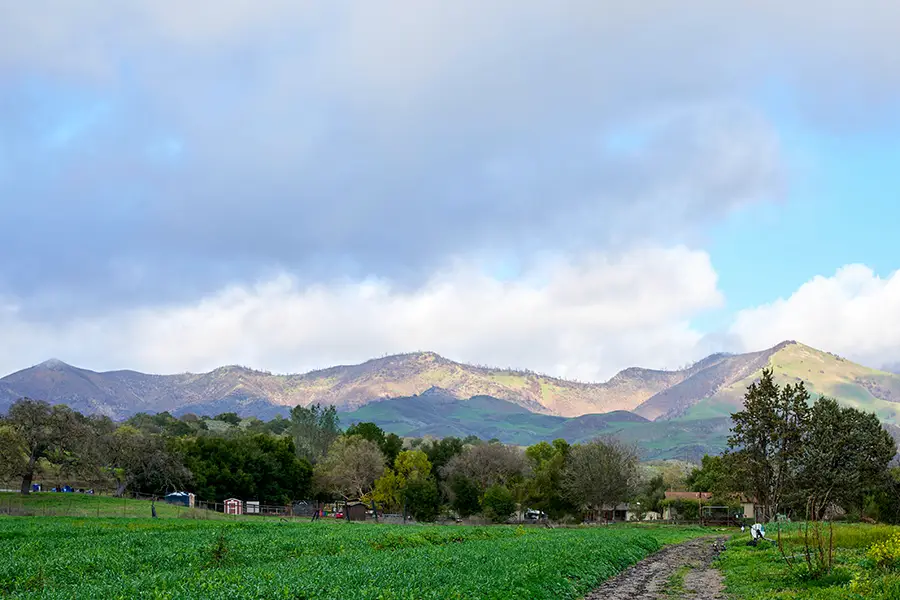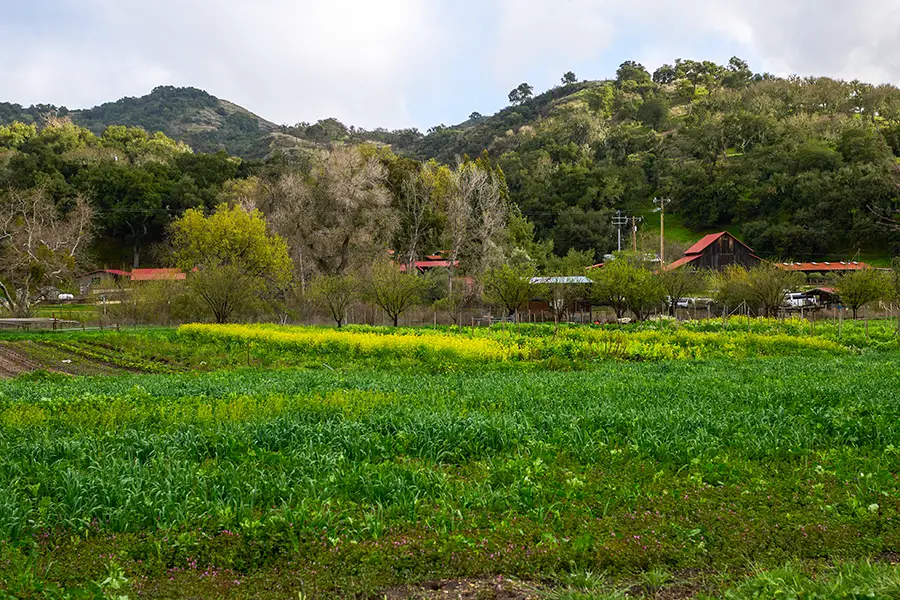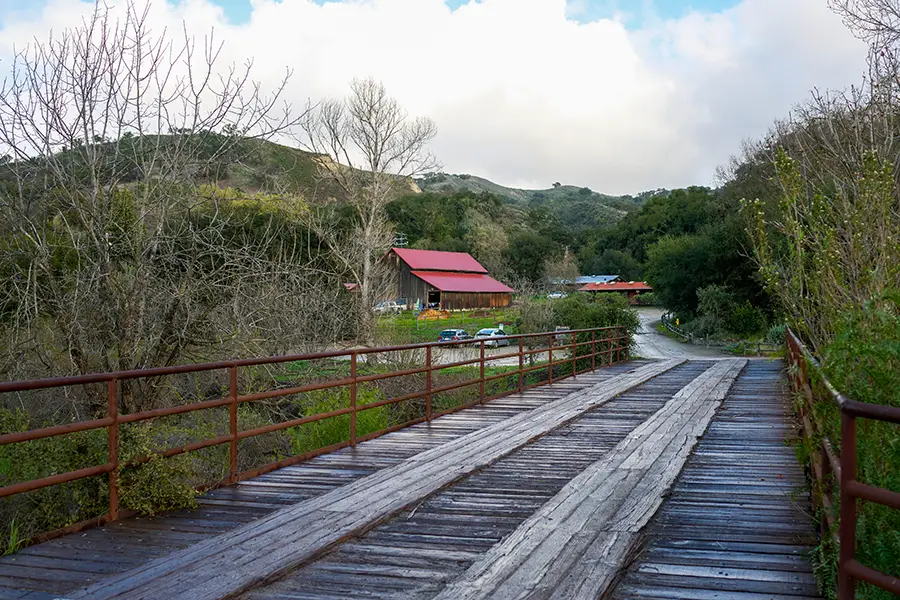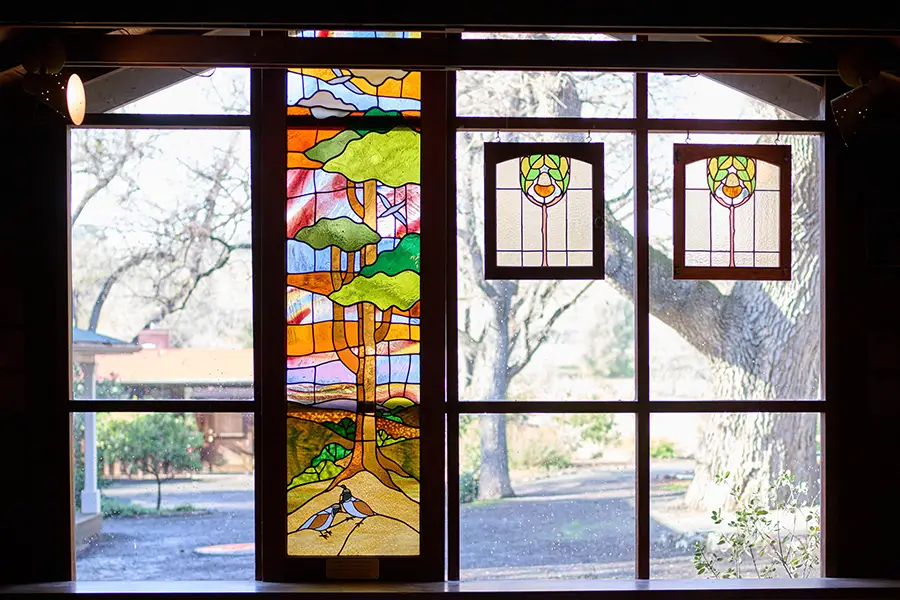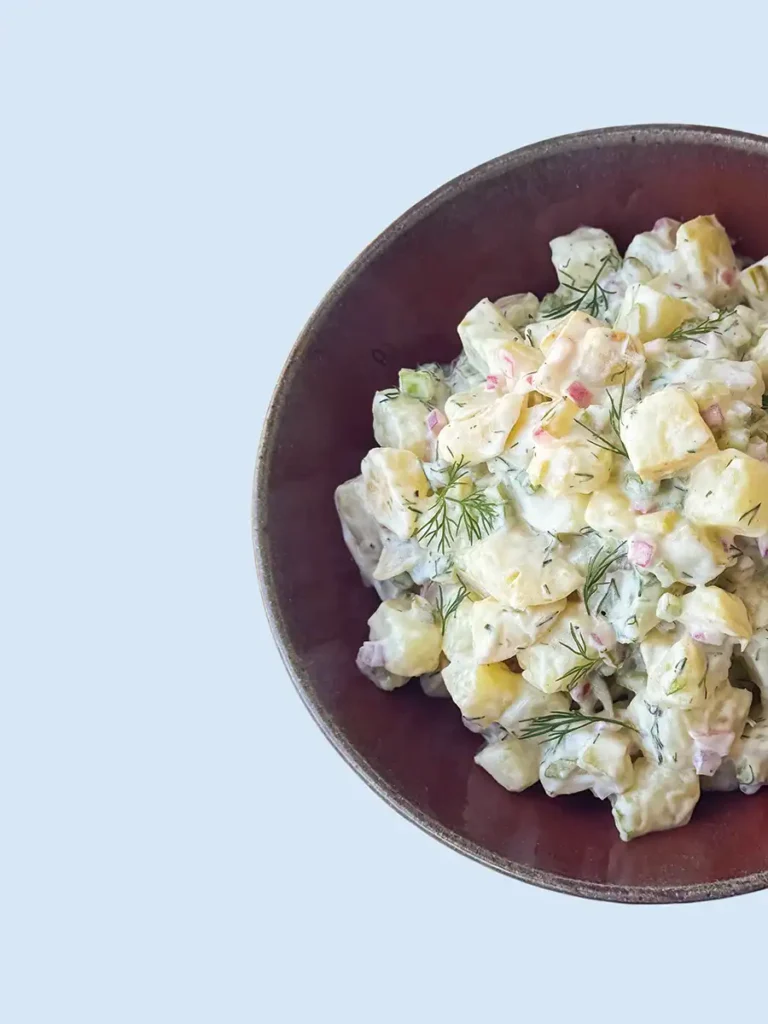Planting Seeds: Farming and Feeding at Midland School in Los Olivos
Photos by Stephen Lewis
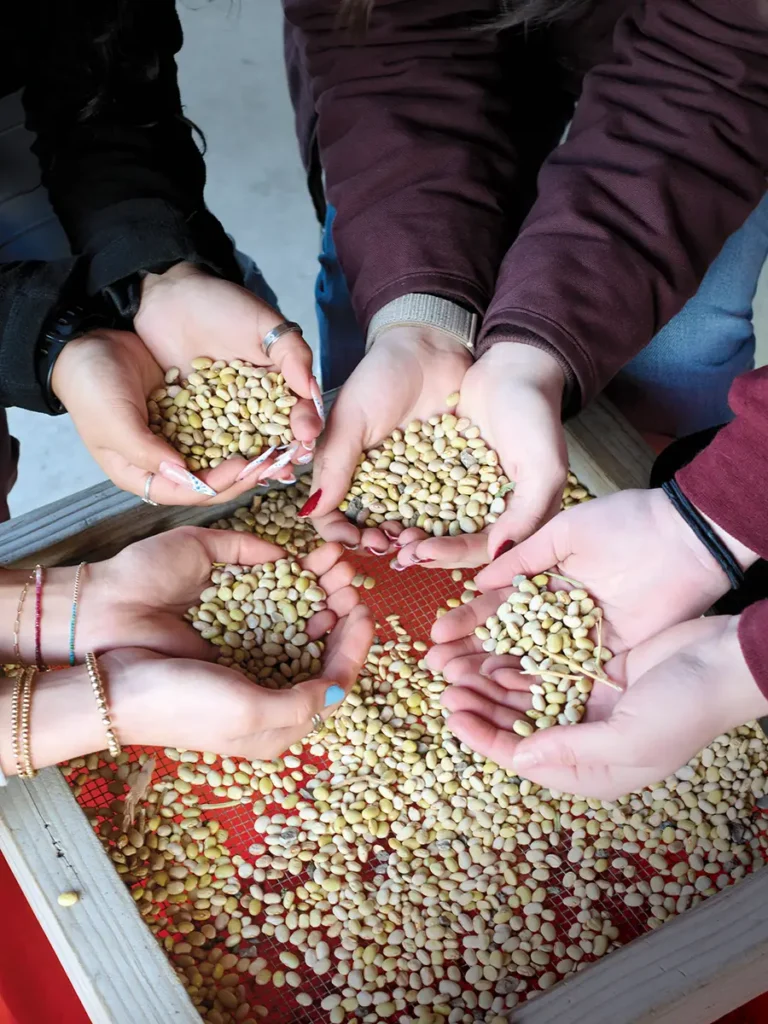
Driving onto the Midland School campus off of Figueroa Mountain Road in Los Olivos on a sunny spring-like January morning makes me smile. Seeing the rustic cabins dotted on the campus in the shadow of Grass Mountain makes me think summer camp. Also a smile. Entering Stillman Dining Hall with the welcoming sweet scents of something baking makes me smile and—well—makes me hungry.
I’m greeted by Kitchen Manager Gloria Murillo. She leads me to a table past a group of students making dumplings for next week’s Lunar New Year celebration. A bowl of roasted butternut squash with strands of baby kale and another of roasted red beets sit center on the table where Gloria and I are seated. The squash is nutty and buttery, and the beets taste as sweet as candy. Gloria promises me that both dishes are simply roasted with some olive oil, salt and pepper.
Maybe the flavors are so remarkable because the vegetables are grown on Midland’s 10-acre certified organic farm just down the path from the dining hall. In the 19 years that Gloria has choreographed Midland’s meals, she hasn’t had to go any further than the campus farm for produce. Vegetables, fruit and flowers have all been within easy reach.
Everything about Midland makes me smile. This is a co-ed college preparatory boarding school unlike any school that I know of. While students study the usual high school courses, Midland does one better in offering an experiential hands-on learning environment. Along with a working ranch, the 2800 acre property boasts more than 35 miles of backcountry trails for hiking, climbing and camping, biking and horseback riding. Some of the students are even allowed to bring their dogs from home, a chicken or two, maybe a fish and an occasional parakeet to live with them on campus.
After all, the campus belongs to the students—all 71 of them, half girls, half boys—and they’re all responsible for maintaining their campus. They have jobs like chopping the wood that fuels the stoves that heat the cabins in which they live. Jobs like feeding the pigs, grooming the horses, herding the cattle, repairing fences, collecting eggs from the chickens, and weeding the gardens. Jobs like growing vegetables and fruit that feed the community of students and faculty, all of whom dine together around communal tables in the dining room where students handle the service and the cleanup. It all matters.
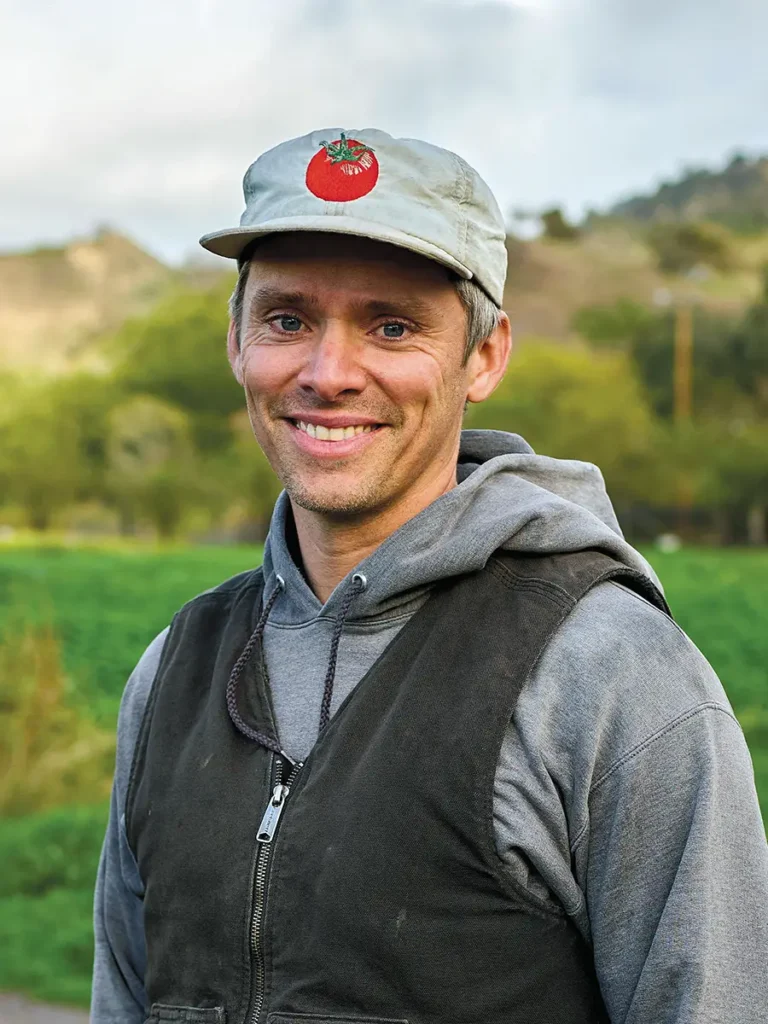
Farm Manager and Educator Michael Sibalski came to the Santa Ynez Valley and specifically to Midland in 2021. With a diverse background from leading mountaineering expeditions to working with young people in a wilderness therapy program, he was ready for his next chapter.
“Falling into the rhythm of life at a boarding school was new to me,” says Michael as we settle at a picnic table on the edge of the farm, a chorus of black birds punctuating every word of our conversation. “Taking over management of Midland’s farm property and having to develop an educational curriculum was initially a real challenge in trying to meet the needs of both the school and the students. But it quickly became clear that teaching kids to grow something, to understand the successes and the struggles of farming and the value of work, teaches them some very critical life skills, such as leadership, problem solving and communications.”
“And, of course, it’s important that they know where their foods come from and how they’re connected to the ecosystems, how they own the land and therefore need to respect it.”
Farm Internship at Midland is a pass/fail course offered to students as one of their electives every semester after freshman year. The school feels strongly that it’s important that kids know their food sources and understand what it takes to get from seed to table. It’s also a perfect way for students to connect with each other and interact with nature in a safe and constructive setting. Working the farm for at least one semester is a requirement for graduation at Midland.
At the time of my visit, there are 14 students divided into two sections involved in Farm Internship. Each section is given their own plot in one of the fields, typically about 1,200 feet of growing space. They get to choose their crops—a mix of produce and/or flowers—based on what will grow best at the particular time of the year. Under Michael’s supervision, the students order seeds and create a crop plan. The seeds are nurtured and grown in a greenhouse until the plants are ready to be transplanted in the fields.
The day-to-day farming chores are all in the students’ hands, including tractor work, soil analysis, irrigation, composting, pest management, weeding, pruning, crop cultivation… and eventually harvesting the crops that they’ve so diligently grown.
“We also take a pause from farm work to talk about leadership skills,” explains Michael. “Farming happens in cycles—seasons and growth cycles. The more a student is involved with the different cycles, the more they’re aware of the various patterns of a plant’s growth. Students are allowed to take Farm Internship for as many semesters as they choose following their freshman year. Those who stay with the course move beyond the basics and are then able to step into leadership roles, mentoring their peers while deepening their own sense of farming.”
“In fact, some of my students choose to focus specifically on developing their leadership skills. In those cases, I meet with each one of them several times during the semester to see how they’re feeling about their growth as leaders—about their productivity on the farm and in leading their fellow students.”
Michael called on a handful of his students to meet with me, most of them in their junior year at Midland and all of them involved in Farm Internship. We gather around a table outside the dining hall. A rooster is crowing in the background lest we forget we’re in the midst of farmland.
“Farming opened my eyes to certain realities,” says Hayden, a student who plans to study agricultural science after graduation. “I had no interest in farming when I first came to Midland, but that changed. Farming has inspired me in so many ways. One of our projects as part of the internship is to understand how our farming goes beyond Midland, how it affects so many people and so many issues all over the world, how our little community has the potential to connect with so many other communities.”
In fact, Midland’s students grow enough produce to feed the school and then some. As Michael puts it, growing enough means you always have extra. That lesson isn’t lost on the students. They get it, that they’ve put in a lot of work to create a productive farm that has the ability to feed the community that surrounds them.
This past year, Midland donated more than two tons of food to Veggie Rescue, a Santa Barbara County–based nonprofit that collects excess produce from farms and, in doing so, delivers food to those who need it while also eliminating waste.
The students fill me with stories about how gratifying it is to be able to donate produce to Veggie Rescue and to those suffering from food insecurities, about Thanksgiving at Midland and how they’re able to share their abundance with those less fortunate.
Thanksgiving is a time when students get together on campus with their families, faculty and alumni to create a three-day event that’s largely about farming and food. In the weeks leading to Thanksgiving, students put in extra hours to ready the produce that will feed their extended Midland family over the holiday. Faculty and alumni join Gloria and her team in the kitchen to put the meal together. Families of students arrive with desserts to share with everyone. Two days after Thanksgiving is Experiential Saturday, when students along with their visiting families continue the harvest and pack up crops for Veggie Rescue, which delivers the food to those in need.
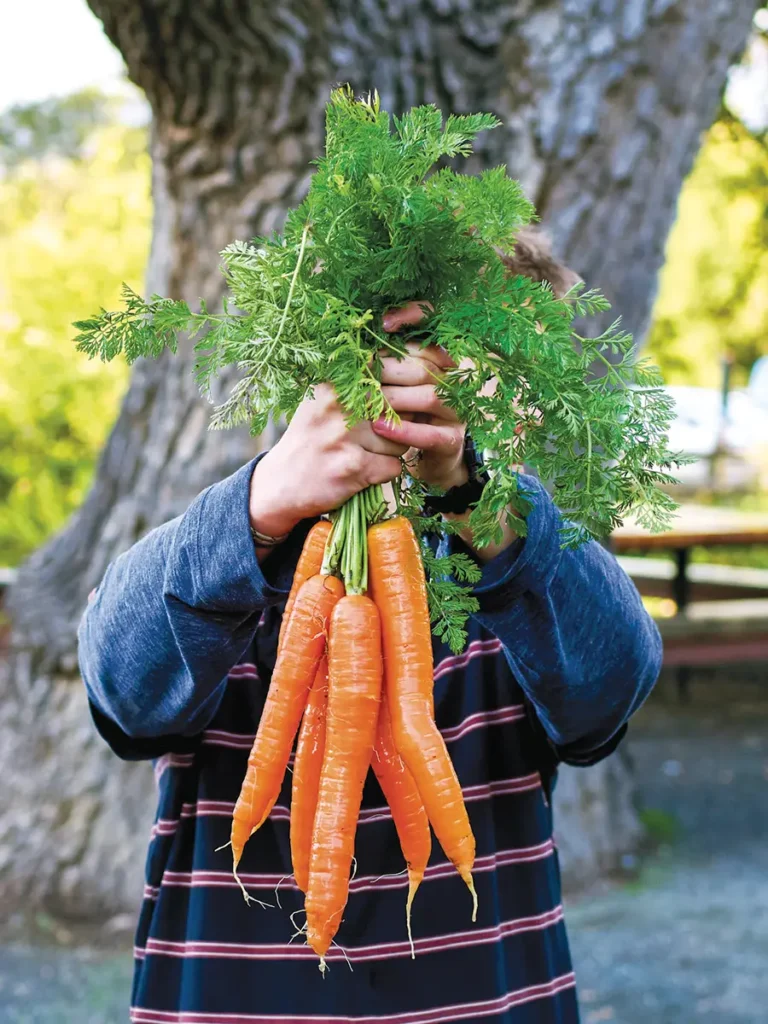
“Working on the farm, we’re feeding ourselves and, at the same time, we’re doing something meaningful in giving back to the community with the extra food we’re growing,” exclaims Mateo.
“That we have a farm makes Midland unique in many ways. Like in the spring, we’ll have a surplus of strawberries. At a time when everyone is stressing about their final exams, we’re told to go out in the field, eat some strawberries and get some sugar in our systems. What other school is like that? What other school has strawberries in their backyard?”
Mateo is farming broccoli and cornflowers this semester. Another student, Julissa, is growing potatoes, as well as Sunset Zinnias, Purple Moonflowers and ‘Classic Magic’ Cornflowers. She came to Midland because of its outstanding horse program and ranch-related activities. She signed up for the Farm Internship because she figured it would be a nice break from academics.
“I absolutely fell in love with farming—everything from pruning the grapevines to planting and picking vegetables and learning about soil science,” gushes Julissa. “But my favorite job is caring for the chickens. I was able to bring my two chickens from home to Midland. They’re at the coop. I can hear them when I’m working in the fields. I’m really lucky because my job now is to tend to the chickens, feed them, clean their coop, make sure they’re happy and collect their eggs for the kitchen.”
One of the students tells me about how disappointing it was when his carefully cultivated pea plants produced nothing. He tried again with a little more success and one more time resulting in a very rewarding and tasty crop of peas. Failure and success are all part of the process of farming, he reminds me.
Another student chimes in that the best part of Farm Internship is being able to eat while she works. Carrots being her favorite.
Mia shares that it’s the quiet and calm that most attracts her to the farm because she finds that plants are simply not as complicated as humans. And that’s a welcome respite during these often-frenetic teen years.
(Did I mention that the kids are munching on a bag of not-necessarily-organic chips with the exception of one who has a sandwich slathered with the kitchen’s homemade peanut butter?)
As I walk back to the dining hall with Michael so that I can pick up my takeouts of roasted squash and beets, Gloria is setting up for lunch. Today’s menu features quiche with tomatoes and peppers and, as always, a bountiful salad bar. The quiche is made with eggs from Julissa’s hens. The tomatoes and peppers were harvested from the farm in late summer, frozen and thawed for meals throughout the winter months, including the nearly 25 pounds of salsa the kitchen goes through every week. And the salad ingredients are, of course, fresh from the farm today.
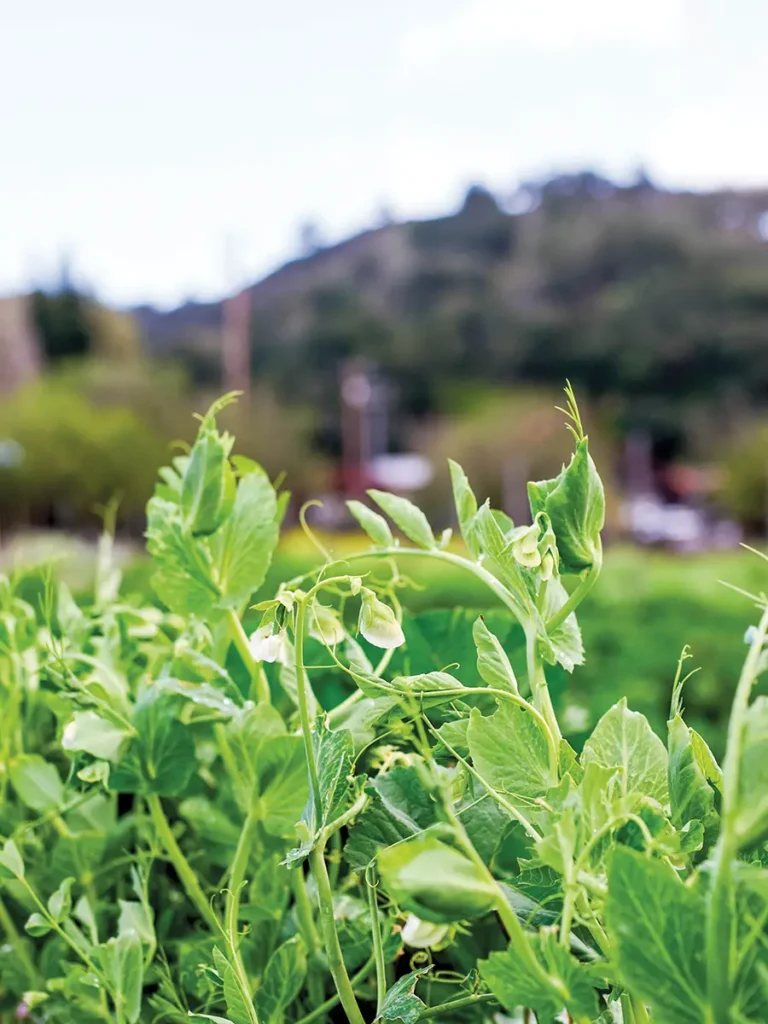
Gloria hands me a copy of her cookbook, Flavors of Midland. Her introduction reads, “Transforming fresh food into delectable dishes makes me happy. My job is my good fortune. My gratitude is reflected back to me as I observe people’s pleasure eating the meals I cook.”
Gloria invites me to stay for lunch. I accept. That makes me happy, too.
“It’s unlikely these kids are going to be farmers when they’re out of school,” says Michael when asked about his vision for the farm program. “I just hope that there’s some bit of understanding that students get from this farming experience. At the very least, that they care about the world in a slightly different way. We need to grow food, because we need to eat. That’s reality. But we need to balance our needs and be thoughtful about how we go about realizing them.”
“I would love to see the students eventually take over the farm. I’ll simply be their guardrail. That will indicate to me that there’s enough experience and knowledge within the student body to do what we have to do to grow the food that we need to grow. More than that, I want the students to feel empowered. I want them to feel that they have some ownership over this place.”
My impression after spending a couple of days at Midland with Michael and his students is that the farm program has clearly enriched these young fertile minds. It’s not that the students will necessarily go into farming, as Michael has said, but there are great lessons to be learned in farming that they then will take with them. And that leaves me with a smile.

